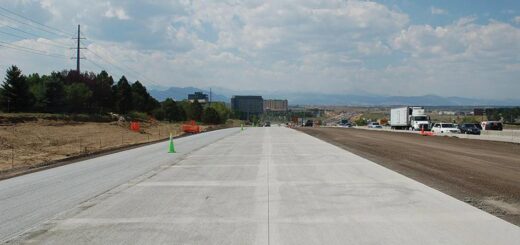Advantages of Rigid Pavement
When it comes to constructing roads and highways, the choice of pavement material plays a crucial role in determining their quality, durability, and performance. One popular type of pavement used in the construction industry is rigid pavement. Rigid pavement, also known as concrete pavement, offers several advantages over other pavement types, making it a preferred choice for many infrastructure projects. This article will explore the various benefits of using rigid pavement and shed light on why it is widely favored in road construction.
Rigid pavement refers to a type of road surface that is constructed using Portland cement concrete (PCC) as the primary material.
It consists of a reinforced or non-reinforced concrete slab that is laid over a prepared subbase. Rigid pavement is known for its strength, stiffness, and ability to distribute loads effectively.
This structural integrity gives it several advantages over flexible pavement alternatives, such as asphalt.
Advantages of Rigid Pavement
- Durability
One of the key advantages of rigid pavement is its exceptional durability.
Concrete, the primary material used in rigid pavement, possesses high compressive strength and can withstand heavy loads and traffic volumes. It can resist the wear and tear caused by vehicular movement and environmental factors, ensuring the road’s longevity.
Unlike the flexible pavements, condition of the road surface is change remains the same for longer durations.
- Load Bearing Capacity
Rigid pavement has excellent load-bearing capacity, making it suitable for heavy-duty applications. It can bear significant traffic loads without experiencing excessive deformation or rutting.
This characteristic is particularly beneficial for highways, airports, industrial yards, and other areas that experience high traffic volumes or heavy equipment.
- No Excessive Deflections
With the change the ground conditions or in places where the high load is applied on the road, there are excessive deflections in the flexible pavements.
However, nature of the construction material avoids the same and concrete acts as a load distributor in this context.
- Low Maintenance
Compared to other pavement types, rigid pavement requires relatively low maintenance.
Once properly constructed, it can withstand harsh weather conditions and frequent usage without significant deterioration. Routine maintenance activities such as joint sealing, crack repairs, and periodic resealing can help prolong its lifespan even further.
- Smooth Surface
Rigid pavement offers a smooth and even surface for vehicles to travel on.
This smoothness contributes to a comfortable and safe driving experience, reducing driver fatigue and enhancing vehicle stability.
The absence of surface irregularities also minimizes the chances of skidding and improves overall road safety.
- Long Lifespan
Due to its robust construction and durability, rigid pavement has a significantly longer lifespan compared to other pavement types.
When designed and built correctly, it can last for several decades with minimal repairs and maintenance. This longevity makes it a cost-effective choice in the long run, as it reduces the need for frequent rehabilitation or reconstruction.
- Reflective Properties
The light-colored surface of rigid pavement reflects a significant amount of sunlight, resulting in lower surface temperatures.
This reflective property helps to mitigate the urban heat island effect in urban areas, reducing the overall heat buildup and making the surroundings more comfortable for pedestrians and motorists.
- Weather Resistance
Rigid pavement exhibits excellent resistance to adverse weather conditions, such as extreme temperatures, freeze-thaw cycles, and moisture.
Its inherent strength and impermeability prevent water infiltration, reducing the risk of damage caused by freezing and thawing cycles.
Additionally, concrete does not soften under high temperatures, ensuring stability even in hot climates.
- Fuel Efficiency
The smooth surface of rigid pavement contributes to reduced rolling resistance for vehicles. With lower rolling resistance, vehicles require less fuel to maintain a given speed, leading to improved fuel efficiency.
This benefit not only saves costs for motorists but also contributes to a greener environment by reducing fuel consumption and emissions.
- Cost-effectiveness
While the initial construction cost of rigid pavement may be higher than that of flexible pavement, its long-term cost-effectiveness is notable.
The reduced maintenance requirements, longer lifespan, and lower life-cycle costs make rigid pavement an economically viable option for many road construction projects.
- Environmentally Friendly
Rigid pavement offers several environmental benefits. Its long lifespan reduces the need for frequent reconstruction, minimizing the consumption of raw materials and energy.
The reflective properties of concrete pavement help mitigate heat island effects, contributing to a more sustainable and comfortable urban environment.
Additionally, the use of locally sourced materials in the construction of rigid pavement reduces transportation-related carbon emissions.
- Enhanced Safety
The smooth and even surface of rigid pavement improves road safety by providing better vehicle control and reducing the risk of skidding. It also offers excellent visibility, especially during nighttime, due to its light-reflective properties.
Furthermore, the reduced maintenance requirements and absence of loose gravel or potholes enhance the safety of both motorists and pedestrians.
- Ease of Construction
Rigid pavement is relatively easy to construct compared to other pavement types. The standardized construction process and quality control measures ensure consistent results.
The use of mechanized equipment for concrete placement and finishing expedites the construction process, minimizing the project duration and reducing disruption to traffic.
- Design Flexibility
Rigid pavement offers design flexibility, allowing engineers to tailor the pavement structure to meet specific requirements.
Various factors, such as anticipated traffic loads, climate conditions, and subgrade characteristics, can be considered during the design phase to optimize the pavement’s performance.
This flexibility ensures that the pavement can adapt to different project needs and site conditions.
- Improved Aesthetics
Rigid pavement provides an aesthetically pleasing appearance to roads and highways.
Its smooth and uniform surface, combined with the ability to incorporate decorative elements or colored concrete, adds visual appeal to the surroundings.
This aspect is particularly relevant for urban areas, where the road network contributes to the overall landscape and urban design.
- Reduced Noise Pollution
Compared to other pavement types, rigid pavement produces less noise.
The solid and rigid nature of the concrete surface reduces the noise generated by vehicle tires, resulting in a quieter environment for nearby residents and businesses.
This noise reduction benefit is especially significant in urban areas, where noise pollution can have a detrimental impact on the quality of life.
In conclusion, rigid pavement offers numerous advantages that make it an attractive choice for road construction projects. Its durability, load-bearing capacity, low maintenance requirements, smooth surface, long lifespan, and various other benefits contribute to its popularity.
Rigid pavement not only provides a reliable and safe transportation infrastructure but also offers environmental and economic advantages. By utilizing concrete as the primary material, we can build roads and highways that withstand the test of time while ensuring a sustainable and efficient transportation network.
Frequently Asked Questions (FAQs)
Q1. Is rigid pavement only suitable for highways?
No, rigid pavement is suitable for a wide range of applications, including highways, airports, industrial yards, parking lots, and residential streets. Its strength, durability, and load-bearing capacity make it versatile for different traffic conditions and usage scenarios.
Q2. How long does rigid pavement last?
Rigid pavement, when properly designed and constructed, can last for several decades. With routine maintenance and timely repairs, it can easily surpass a lifespan of 30 to 50 years. Factors such as traffic volume, environmental conditions, and maintenance practices can influence the actual lifespan of rigid pavement.
Q3. Does rigid pavement require frequent repairs?
Rigid pavement is known for its low maintenance requirements. While occasional repairs may be necessary, they are typically minimal and can be addressed through activities like joint sealing and crack repairs. Regular inspections and preventive maintenance measures can help identify and resolve any issues before they escalate.
Q4. Is rigid pavement more expensive to construct compared to other pavement types?
The initial construction cost of rigid pavement is generally higher than that of flexible pavement types like asphalt. However, when considering the long-term costs and benefits, rigid pavement proves to be cost-effective. Its durability, extended lifespan, and reduced maintenance needs result in lower life-cycle costs, making it a viable investment over time.
Q5. Is rigid pavement environmentally friendly?
Yes, rigid pavement offers several environmental benefits. Its long lifespan reduces the need for frequent reconstruction, minimizing the consumption of raw materials and energy. The reflective properties of concrete pavement help mitigate the urban heat island effect, contributing to a more sustainable and comfortable urban environment. Additionally, the use of locally sourced materials in its construction reduces transportation-related carbon emissions.




